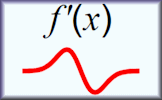Here are some specific activities, investigations or visual aids we have picked out. Click anywhere in the grey area to access the resource.
 Calculus Grapher Given a function, predict the integral, first derivative, or second derivative curves.
Calculus Grapher Given a function, predict the integral, first derivative, or second derivative curves. Differentiation Video A reminder of how to differentiate different types of functions and how to find the equations of tangents and normals.
Differentiation Video A reminder of how to differentiate different types of functions and how to find the equations of tangents and normals. Differentiation Practise the technique of differentiating polynomials with this self marking exercise.
Differentiation Practise the technique of differentiating polynomials with this self marking exercise.
Here are some exam-style questions on this statement:
- "A function is given as \(f(x)=3x^2-6x+4+\frac3x,-2\le x \le 4, x\ne 0\)." ... more
- "Consider the graph of the function \(f(x)=7-3x^2-x^3\)" ... more
- "A child's play tent is made in the shape of half a cylinder. It is constructed from a fibreglass frame with material pulled tightly around it. The fibreglass frame consists of a rectangular base, two semi-circular ends and two further support rods, as shown in the following diagram." ... more
- "A package is in the shape of a cuboid and has a length \(l\) cm, width \(w\) cm and height of 12 cm." ... more
- "Consider the function \(f(x)=6 - ax+\frac 3{x^2},x\neq 0\)" ... more
- "If \(f(x)=x\sin{x}\), for \(-3\le x\le3\)" ... more
- "Consider the cubic function \(f(x)=\frac{1}{6}x^3-2x^2+6x-2\)" ... more
- "Consider the function \(f(x)=x^3-9x+2\)." ... more
- "Let \(f(x)=\frac{g(x)}{h(x)}\), where \(g(3)=36\), \(h(3)=12\), \(g'(3)=10\) and \(h'(3)=4\). Find the equation of the normal to the graph of \(f\) at \(x=3\)." ... more
- "The function \(f\) is defined as follows:" ... more
- "Consider the functions" ... more
- "Let \(f(x)=jx^3+jx^2+kx+m\) where \(j, k\) and \(m\) are constants." ... more
- "The following diagram shows part of the graph of \(y=f (x)\)" ... more
- "Let \(f(x) = \frac{ln3x}{kx} \) where \( x \gt 0\) and \( k \in \mathbf Q^+ \)." ... more
- "Consider the function \(f(x)=\frac{20}{x^2}+kx\) where \(k\) is a constant and \(x\neq0\)." ... more
Click on a topic below for suggested lesson Starters, resources and activities from Transum.
Furthermore
A local maximum is a point where a function has a higher value than at nearby points, making it a peak in the graph. Conversely, a local minimum is a point where the function has a lower value than its neighbours, forming a trough. To test for these points, we often use the first and second derivative tests. If \( f'(x) \) changes sign from positive to negative as \( x \) increases, \( f(x) \) has a local maximum. If \( f'(x) \) changes from negative to positive, \( f(x) \) has a local minimum. The second derivative test states that if \( f''(x) > 0 \) at a point where \( f'(x) = 0 \), then \( f(x) \) has a local minimum. If \( f''(x) < 0 \), it's a local maximum.
Optimisation involves finding the maximum or minimum values of a function in a given domain, which has numerous applications in real-world scenarios, such as maximising profit or minimising cost.
A point of inflexion is where a curve changes its curvature direction. If the curve changes from concave upwards to concave downwards (or vice versa), it's an inflexion point. At these points, \( f''(x) = 0 \) or is undefined. However, not all points where \( f''(x) = 0 \) are inflexion points. The gradient at an inflexion point can be zero (a horizontal tangent) or non-zero.
Examples:
1) Consider the function \( f(x) = x^3 - 3x^2 \).
The first derivative is \( f'(x) = 3x^2 - 6x \) and the second derivative is \( f''(x) = 6x - 6 \).
Setting \( f'(x) = 0 \), we get \( x = 0 \) and \( x = 2 \). Using the second derivative test, we find that \( f(x) \) has a local maximum at \( x = 0 \) and a local minimum at \( x = 2 \).
2) For the function \( g(x) = x^4 - 4x^3 \),
The first derivative is \( g'(x) = 4x^3 - 12x^2 \) and the second derivative is \( g''(x) = 12x^2 - 24x \).
Setting \( g''(x) = 0 \), we get \( x = 0 \) and \( x = 2 \). Both of these are points of inflexion, but only \( x = 2 \) has a gradient of zero.
This video on the Basics of Differentiation is from Revision Village and is aimed at students taking the IB Maths Standard level course
This video on Optimization and Calculus Curves is from Revision Village and is aimed at students taking the IB Maths AA SL/HL course.
If you use a TI-Nspire GDC there are instructions useful for this topic.
How do you teach this topic? Do you have any tips or suggestions for other teachers? It is always useful to receive feedback and helps make these free resources even more useful for Maths teachers anywhere in the world. Click here to enter your comments.

